Carl Walther GmbH Sportwaffen, or simply known as Walther, is a German firearm manufacturer, and a subsidiary of the PW Group. Founded by Carl Walther in 1886, the company has manufactured firearms and air guns at its facility in Germany for more than 100 years. Walther Arms, Inc. is the United States Walther business unit and is based in Fort Smith, Arkansas.

A semi-automatic pistol is a handgun that automatically ejects and loads cartridges in its chamber after every shot fired. Only one round of ammunition is fired each time the trigger is pulled, as the pistol's fire control group disconnects the trigger mechanism from the firing pin/striker until the trigger has been released and reset.

The Walther P99 is a semi-automatic pistol developed by the German company Carl Walther GmbH Sportwaffen of Ulm for law enforcement, security forces and the civilian shooting market as a replacement for the Walther P5 and the P88. The P99 and its variants are also made under licence by Fabryka Broni Radom.
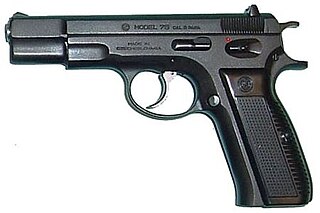
The CZ 75 is a semi-automatic pistol made by Czech firearm manufacturer ČZUB. First introduced in 1975, it is one of the original "wonder nines" and features a staggered-column magazine, all-steel construction, and a hammer forged barrel. It is widely distributed throughout the world and is the most common handgun in the Czech Republic.

The SIG Sauer P220 is a semi-automatic pistol designed in 1975 by the SIG Arms AG division of Schweizerische Industrie Gesellschaft, and produced by J. P. Sauer & Sohn, in Eckernförde. It is currently manufactured by both SIG Sauer companies: SIG Sauer GMBH, of Eckernförde, Germany; and SIG Sauer, Inc., of New Hampshire, United States.
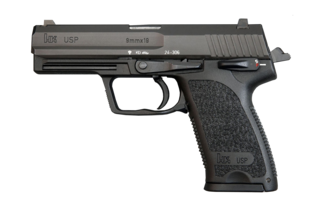
The USP is a semi-automatic pistol developed in Germany by Heckler & Koch GmbH (H&K) as a replacement for the P7 series of handguns.

The Walther P38 is a 9 mm semi-automatic pistol that was developed by Carl Walther GmbH as the service pistol of the Wehrmacht at the beginning of World War II. It was intended to replace the comparatively complex and expensive to produce Luger P08. Moving the production lines to the more easily mass producible P38 once World War II started took longer than expected, leading to the P08 remaining in production until September 1942 and copies remained in service until the end of the war.

The Heckler & Koch P2000 is a German semi-automatic pistol introduced late in 2001 and intended primarily for law enforcement, paramilitary, and commercial markets. It is based on the USP Compact pistol. The P2000 was designed specifically with improved ergonomic characteristics; it has features that reduce handling related stresses, while at the same time increasing user handling and comfort.

The Heckler & KochP7 is a German 9×19mm semi-automatic pistol designed by Helmut Weldle and produced from 1979 to 2008 by Heckler & Koch GmbH (H&K). The P7M13, a variant of the P7 with a double-stack magazine, was produced until 2000.

The Thunder 9 is a full-size semi-automatic handgun manufactured by Bersa at the Ramos Mejia production plant in Argentina. It is also sold under the name Firestorm or FS 9.

The Beretta Px4 Storm is a semi-automatic pistol intended for personal defense and law enforcement use. It is available in full size, Compact, and Subcompact versions. The Px4 uses a trigger and safety system similar to the Beretta 92 and the Beretta 8000 series, though it is distinguished from its predecessors by its light-weight polymer construction with steel inserts, standard Picatinny rail, and swappable grip backstraps. The full size and Compact versions use the same short-recoil, rotating barrel action as the Beretta 8000 series, whereas the Subcompact uses the tilt barrel system.
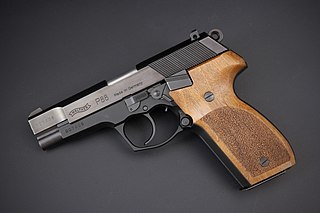
The Walther P88 is a semiautomatic pistol developed by German company Walther. Its main feature is a high-capacity double-stacked magazine designed for military and law enforcement use. The P88 was succeeded by the Walther P99 in 1997.

The Beretta 8000 (Cougar) is a family of rotating barrel semi-automatic pistols that were designed and manufactured by Beretta of Italy.
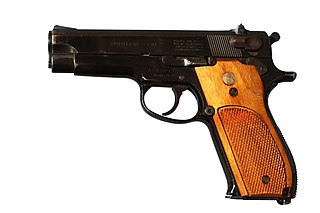
The Smith & Wesson Model 39 is a semi-automatic pistol developed for the United States Army service pistol trials of 1954. After the Army abandoned its search for a new pistol, the Model 39 went on the civilian market in 1955 and was the first of Smith & Wesson's first generation semi-automatic pistols.

The Vektor SP1 was an improved 9mm version of the Z-88 pistol, produced since 1992 by Denel Land Systems (DLS), formerly Lyttelton Engineering Works (LIW).
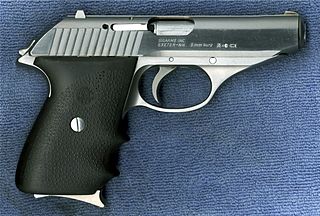
The SIG Sauer P230 is a small, semi-automatic handgun chambered in .32 ACP or .380 Auto. It was designed by SIG Sauer of Eckernförde, Germany. It was imported into the United States by SIGARMS in 1985. In 1996 it was replaced by the model P232.
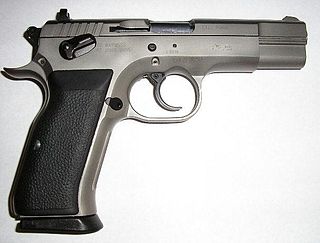
The Tanfoglio Combat or Standard, also known as T(A)95 or EAA Witness Steel, is a modified clone of the Czech CZ-75/CZ-85 pistol. It is made in Gardone Val Trompia near Brescia, Italy by Fratelli Tanfoglio S.N.C.

The Walther PK380 is a semi-automatic pistol manufactured by Carl Walther GmbH Sportwaffen.

The Walther PPQ is a semi-automatic pistol developed by the German company Carl Walther GmbH Sportwaffen of Ulm for law enforcement, security forces and the civilian shooting market as a development of the Walther P99. It is available in 9×19mm Parabellum, 9×21mm, .40 S&W, and .45 ACP chamberings.
The PHP was the first major production pistol in Croatia, chambered in the 9×19mm Parabellum cartridge.




















